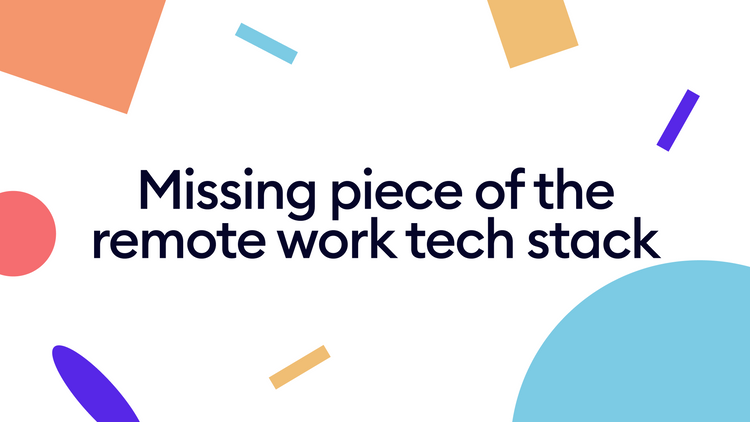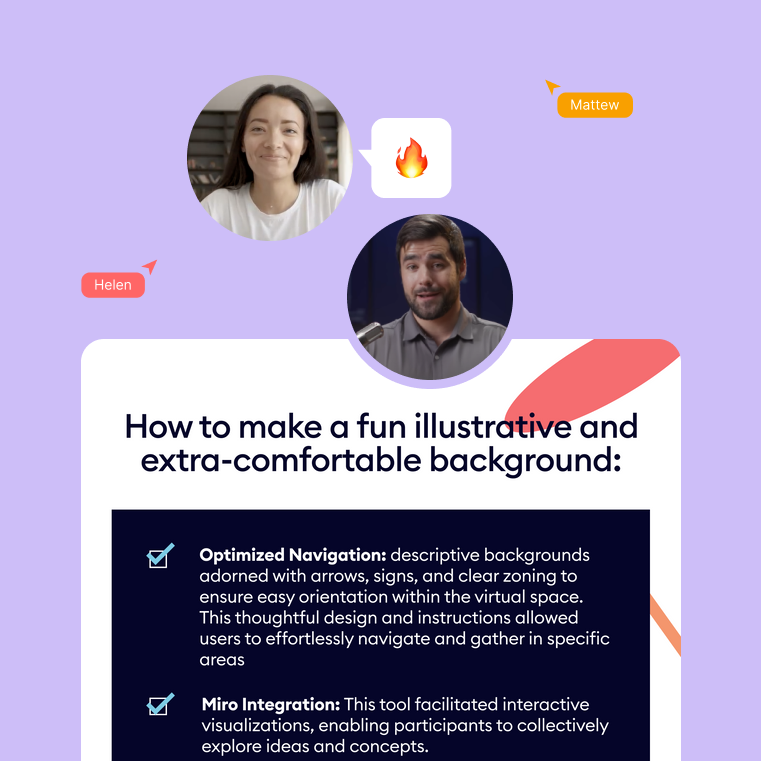Missing piece of the remote work tech stack
David O. Sacks suggested that remote work is equivalent to a two-day workweek, while Sam Altman argued that this approach is unsuitable for startups and declines productivity. Let's explore the reasons behind their views on the failure of remote work.

During the COVID-19 pandemic, organizations worldwide were forced to adapt to new ways of working due to the limitations imposed by lockdowns and social distancing measures. We have entered the largest experiment on the new paradigm on how we work. This necessity resulted in the rapid adoption of digital tools and remote work practices. Surprisingly, this shift had some positive outcomes, becoming one of the silver linings of the pandemic.
However the opposite voices and constructive criticism regarding remote work became more solid. David O. Sacks suggested that remote work is equivalent to a two-day workweek, while Sam Altman argued that this approach is unsuitable for startups and declines productivity.
Let's explore the reasons behind their views on the failure of remote work.
Unleashing workplace happiness: employee satisfaction and flexibility
Big tech companies invested tons of resources in providing amenities, from free food and massages to game rooms and on-site laundry. These companies stop at nothing to ensure their employees are happy. When employees feel valued and appreciated, they are likelier to be engaged and motivated on the job. It leads to better work quality and higher levels of productivity overall. In this case it makes sense that the big tech companies would want to keep their workers happy.
After all, we're now in a highly competitive industry where every advantage counts. If team members are satisfied, they'll be well on their way to maintaining their position at the top.
The COVID-19 pandemic has prompted a shift in employee preferences as they now seek flexibility in their work arrangements. Flexibility is not about changing your office curtains to the fancy coffee shop in your city downtown; it’s instead about a personalized working experience for creative professionals.
Increasingly, we think of work as an activity that can be done anywhere. But there's still an advantage in separating work from non-work locations such as homes, hotels, or airplanes. There is value in going to work, switching contexts completely, and stepping into a different environment.
By the end of the COVID-19 we see the two distinct groups emerged: companies that value the employees' need for flexibility with their wish to switch themselves and those who feel the firms are more successful being offsite.
Examining the nuances of remote work: task types and challenges
Let's have a more detailed look at the lens of the types of tasks and see the difference between those that should and should not be performed remotely:
- Individual procedural tasks can be performed remotely in an async manner.
- Focused creative tasks such as writing code or designing a website require little teamwork and are the easiest to transition to teamwork.
- Coordinated group tasks, such as town halls, regular review meetings, and group information sharing, may be standardized but require social interactions. These tasks are more challenging to accomplish with remote participants but totally possible.
- Collaborative creative tasks – strategic planning, creative problem-solving, and brainstorming are the most difficult to transition into a hybrid/remote environment. The last one seems the most underrepresented among tooling, and it seems none of the solutions on the market solves the problem well. They are relatively poor in fostering high-quality interactions, especially among people who don’t know each other. The whole virtual office concept emerged to bring back the serendipitous encounters.
If you listen to the remote work advocates, their pitch will be more or less similar – remote work is the process and skill: more async communication, documentation, and structure. Documenting everything is not easy but is the key to building async workplaces that don’t collapse under pressure. That’s I think where it fails. It requires an additional set of skills both on the individual and the group level.
The findings are unlikely to be surprising to those who have spent a significant amount of time working from a dining-room table in recent years. Collaborating from home poses challenges, and although many have become skilled at using platforms like Zoom, Webex, Teams, or Slack since 2020, there is a potential long-term consequence: the limited growth of human potential.
So, how do you make remote work not re-invent three times more processes? The simple answer is to make it as close to being co-located. Specifically, that will enable synchronous communication over asynchronous communication, more real-time collaboration, and more overlapping working hours.
Power of spontaneity and creative co-creation
Remote work is all about building trust. Accomplishment and capability are prioritized over activity. Trust is essential for great business results and is a foundational element of culture.
The pitfalls of the remote work culture is that every interaction needs to be scheduled and that prevents the bloom of fresh ideas. For a team to do the best work of their lives together, inclusive communication is necessary, involving an environment capable of reproducing the in-person socializing experiences and enabling the facilitation of work together (desks, whiteboards, pencils, paper, projectors, etc. - in-person and their virtual counterparts).
The web was designed with individual contributors in mind. But now it’s all about collaboration experience bringing legacy applications into a multiplayer mode. The first iterations of software are built around files and formats. Other means of communication were designed to facilitate collaboration and idea exchanges (ex: sending the .psd file over email). The file-based semantics enables users to work offline with their data and maintain custody of it. If you want to brainstorm an idea with a colleague, you have to come over to him and sit watching him work.
A new cohort of browser-first applications (Figma, Google Docs, Miro) appeared over the last decade, leveraging this trend. The final output of the work is stored in the cloud and edited as well, thus making it much easier to involve your colleague from other departments in the design process.
In case of collaboration offline, the energy and dynamics that arise from huddling in a room, slapping sticky notes on a wall, or scribbling on a whiteboard is really special, although there's a bunch of tools that helps to facilitate the process online. These tangible activities not only reduce the time spent on ill-conceived ideas but also set an inclusive tone and rally support for projects. The process itself, whether yielding actionable outcomes or simply fostering a sense of togetherness, is seen as crucial.
The concept of a hybrid environment (for example, four of us sitting in the conference room while Alice and Jung join remotely through Zoom), is fundamentally flawed when it comes to fostering creative collaboration. This approach creates a distinct division between individuals present physically and those participating virtually, establishing a hierarchy of importance that leds to the risk of culture erosion. Additionally, we tend to overlook the significance of spontaneous interactions and the psychological impact of being able to approach colleagues without pre-scheduled meetings or casually discussing new ideas over lunch.
Most of the tools we use today were designed before companies decided to embrace a hybrid way of working, and as such they are not optimized around that. Finding ways to replicate the energetic and spontaneous nature of in-person brainstorming sessions is crucial for remote teams.
Human connection on SpatialChat, and how we rethought the process of collaboration
Visual engagement helps us relate to each other on a more personal level. Virtual calls may feel less amenable to that, so a team has to be intentional to create space for empathy and human connection.
By 2020 we speculated that video conferencing was a broken UX, and there was no shortage of greenfield space for spatial thinking in this space. For example, there were only two ways to view a meeting: Speaker View or Gallery View. Are you ever looking at a grid of faces in real life? Never. It's not natural. In real life, you look at people around a dinner table, or around a circle at a standup meeting, or at someone beside you as you go for a walk.
Video conferencing software removes those spatial elements, making meetings more complicated. The power of spatial thinking in social software is not just about connecting people but creating a more substantial feeling or sense that they are close.
We rethought video meetings and supercharged them with SpatialChat Breakout and Workplace rooms that enable you to do any video meeting with a powerful socializing feeling and collaboration tools. We equipped you with the tools necessary to collaborate and stay connected, even if you are located in different time zones.
While we acknowledge that this solution may not fully replicate the benefits of physical proximity, we strive to facilitate a seamless experience for teams to continue working together effectively.
Helpful materials
Here are some helpful links and great resources to dive deeper into the world of SpatialChat.
Let's explore it😊

Basics of SpatialChat
Let's kick things off with some simple guidelines to help you begin your journey of interacting.

Use cases Guides
Discover creative ways to enhance your virtual interactions and collaborations..
